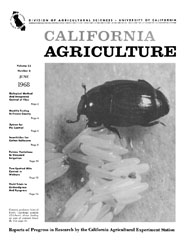


University of California
California Agriculture
|
|||
|
|||

Common predatory histerid beetle, Carcinops pumilio (Erichson), shown feeding on eggs of common house fly.
June 1968
Volume 22, Number 6 |
|||
|
University of California, 1301 S. 46th St., Bldg. 478 Richmond, CA
|